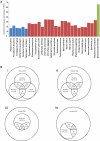The human postsynaptic density shares conserved elements with proteomes of unicellular eukaryotes and prokaryotes
- PMID: 21503141
- PMCID: PMC3071500
- DOI: 10.3389/fnins.2011.00044
The human postsynaptic density shares conserved elements with proteomes of unicellular eukaryotes and prokaryotes
Abstract
The animal nervous system processes information from the environment and mediates learning and memory using molecular signaling pathways in the postsynaptic terminal of synapses. Postsynaptic neurotransmitter receptors assemble to form multiprotein complexes that drive signal transduction pathways to downstream cell biological processes. Studies of mouse and Drosophila postsynaptic proteins have identified key roles in synaptic physiology and behavior for a wide range of proteins including receptors, scaffolds, enzymes, structural, translational, and transcriptional regulators. Comparative proteomic and genomic studies identified components of the postsynaptic proteome conserved in eukaryotes and early metazoans. We extend these studies, and examine the conservation of genes and domains found in the human postsynaptic density with those across the three superkingdoms, archaeal, bacteria, and eukaryota. A conserved set of proteins essential for basic cellular functions were conserved across the three superkingdoms, whereas synaptic structural and many signaling molecules were specific to the eukaryote lineage. Genes involved with metabolism and environmental signaling in Escherichia coli including the chemotactic and ArcAB Two-Component signal transduction systems shared homologous genes in the mammalian postsynaptic proteome. These data suggest conservation between prokaryotes and mammalian synapses of signaling mechanisms from receptors to transcriptional responses, a process essential to learning and memory in vertebrates. A number of human postsynaptic proteins with homologs in prokaryotes are mutated in human genetic diseases with nervous system pathology. These data also indicate that structural and signaling proteins characteristic of postsynaptic complexes arose in the eukaryotic lineage and rapidly expanded following the emergence of the metazoa, and provide an insight into the early evolution of synaptic mechanisms and conserved mechanisms of learning and memory.
Keywords: brain; comparative genomics; phylogenetics; proteome; synapse.
Figures




Similar articles
-
Evolution of synapse complexity and diversity.Annu Rev Neurosci. 2012;35:111-31. doi: 10.1146/annurev-neuro-062111-150433. Annu Rev Neurosci. 2012. PMID: 22715880 Review.
-
Comparative study of human and mouse postsynaptic proteomes finds high compositional conservation and abundance differences for key synaptic proteins.PLoS One. 2012;7(10):e46683. doi: 10.1371/journal.pone.0046683. Epub 2012 Oct 5. PLoS One. 2012. PMID: 23071613 Free PMC article.
-
Evolutionary expansion and anatomical specialization of synapse proteome complexity.Nat Neurosci. 2008 Jul;11(7):799-806. doi: 10.1038/nn.2135. Epub 2008 Jun 8. Nat Neurosci. 2008. PMID: 18536710 Free PMC article.
-
Evolution of complexity in the zebrafish synapse proteome.Nat Commun. 2017 Mar 2;8:14613. doi: 10.1038/ncomms14613. Nat Commun. 2017. PMID: 28252024 Free PMC article.
-
A general basis for cognition in the evolution of synapse signaling complexes.Cold Spring Harb Symp Quant Biol. 2009;74:249-57. doi: 10.1101/sqb.2009.74.033. Epub 2009 Dec 2. Cold Spring Harb Symp Quant Biol. 2009. PMID: 19955255 Review.
Cited by
-
Synapse molecular complexity and the plasticity behaviour problem.Brain Neurosci Adv. 2018 Nov 15;2:2398212818810685. doi: 10.1177/2398212818810685. eCollection 2018 Jan-Dec. Brain Neurosci Adv. 2018. PMID: 32166154 Free PMC article. Review.
-
Divergent Evolution of a Protein-Protein Interaction Revealed through Ancestral Sequence Reconstruction and Resurrection.Mol Biol Evol. 2021 Jan 4;38(1):152-167. doi: 10.1093/molbev/msaa198. Mol Biol Evol. 2021. PMID: 32750125 Free PMC article.
-
Early Origin and Evolution of the Angelman Syndrome Ubiquitin Ligase Gene Ube3a.Front Cell Neurosci. 2017 Mar 7;11:62. doi: 10.3389/fncel.2017.00062. eCollection 2017. Front Cell Neurosci. 2017. PMID: 28326016 Free PMC article. Review.
-
Targeting calpain in synaptic plasticity.Expert Opin Ther Targets. 2013 May;17(5):579-92. doi: 10.1517/14728222.2013.766169. Epub 2013 Feb 4. Expert Opin Ther Targets. 2013. PMID: 23379852 Free PMC article. Review.
-
Synaptic proteome changes in mouse brain regions upon auditory discrimination learning.Proteomics. 2012 Aug;12(15-16):2433-44. doi: 10.1002/pmic.201100669. Proteomics. 2012. PMID: 22696468 Free PMC article.
References
-
- Castresana J. (2000). Selection of conserved blocks from multiple alignments for their use in phylogenetic analysis. Mol. Biol. Evol. 17, 540–552 - PubMed
-
- Cheng D., Hoogenraad C. C., Rush J., Ramm E., Schlager M. A., Duong D. M., Xu P., Wijayawardana S. R., Hanfelt J., Nakagawa T., Sheng M., Peng J. (2006). Relative and absolute quantification of postsynaptic density proteome isolated from rat forebrain and cerebellum. Mol. Cell Proteomics 5, 1158–117010.1074/mcp.D500009-MCP200 - DOI - PubMed
Grants and funding
LinkOut - more resources
Full Text Sources
Molecular Biology Databases

